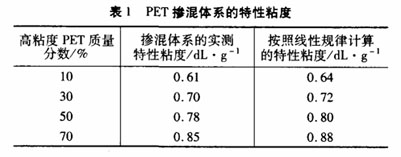Abstract The physical viscosity increasing and chemical viscosifying process of recycled PET bottles were studied. The results show that both of these processes can effectively increase the viscosity of recycled PET bottles. The mechanical properties of fire-retardant reinforced composites made from recycled PET bottles are significantly higher than those of non-tackified PET bottles. The intrinsic viscosity of Tackified PET is additive to the viscosity of each blended component; the epoxy resin chain extender is superior to the oxazoline chain extender in the chemical tackifying effect.
Key words Polyethylene terephthalate recycling Viscosity
With the rapid development of the packaging industry, polyethylene terephthalate (PET) is used in a large number of packaging bottles, especially disposable packaging bottles. At present, there are hundreds of tons of waste PET bottles produced each year in China. How to effectively recycle and use waste PET bottles to save resources and reduce environmental pollution has become a general concern of the whole society.
The intrinsic viscosity of raw materials for general PET bottles is 0. 65 ~0.75dL/go Considering the possible degradation of recycled PET bottles, the intrinsic viscosity of the selected PET bottles is 0.60~0.75 dWg. Compared with PBT, PET has the disadvantages of poor toughness and low elongation at break. Composites based on PET have poor drop impact resistance and are susceptible to cracking when tapped. The mechanical properties of low-viscosity PET are even worse, which is not conducive to the dispersion of materials such as glass fiber, flame retardant, and toughening agent. These drawbacks can seriously hinder the recycling of recycled PET bottles. By increasing the viscosity of recycled PET bottles, the molecular weight of PET can be increased, and the impact strength and elongation at break can be improved. At the same time, the dispersibility of other materials in PET can also be improved.
The authors used physical blending and chemical chain-extension techniques to tackify PET bottle regrind to achieve reuse of PET bottle regrind.
First, the experimental part
(a) The main raw material PET bottle recycled materials: intrinsic viscosity greater than 0.6 dL / g, commercially available;
High-viscosity PET: Intrinsic viscosity 1. O dL / g, Shantou Ocean First Polyester Resin Co., Ltd.;
Chain extender: Epoxy resin (EP), commercially available;
Chain extenders: oxazolines, commercially available.
(II) Major Instruments and Equipment
Twin-screw Extruder: TE-35 type, Nanjing Colophonia Co.;
Melt flow rate (MFR) instrument: CLPXRZ-400 type, Science and Education Instrument Factory of Jilin University.
(3) PET viscosifying process Physical viscosifying is the melting and blending of the materials of the recycled PET bottle recycled material in a heated twin-screw extruder. Chemical viscosifying is the blending of the PET bottle regrind with the chain extender, melt viscosifying in a heated twin-screw extruder, and stranding of the strands.
(d) Determination of Intrinsic Viscosity of PET
The PET was dissolved in a mixed solution of phenol B carbon tetrachloride (1:1) at 25 Torr, and the intrinsic viscosity of PET was measured with an Ubbelohde viscometer.
Second, the results and discussion
(a) physical adhesion
1. The principle of physical adhesion
Physical viscosifying is the physical blending of high-viscosity PET and low-viscosity PET bottle regrind to increase the intrinsic viscosity of PET bottle regrind. The physical blending not only improves the mechanical properties of the low-viscosity component, but also improves the fluidity of the high-viscosity component, while reducing the stress cracking of the PET due to the widening of the molecular weight distribution. This physical viscosifying process is simple and easy, and it has broad application prospects for the modification of polymer materials.
2. Selection of high viscosity PET
The blending of high-viscosity components and low-viscosity components needs to follow certain principles. If the viscosity of the high-viscosity component is too high, a kinetically unstable separation structure will be formed with the low-viscosity component, deteriorating the performance of the blended system; if the viscosity of the high-viscosity component is excessively low, the blended system will achieve A certain viscosity needs to be blended with a higher proportion of high-viscosity components, so that the use ratio of PET bottle recycled materials is reduced, and the purpose of using a large amount of recycled PET bottles cannot be achieved. Considering comprehensively, we chose PET with an intrinsic viscosity of 1.0 dL/g as the high viscosity component.
High-viscosity PET with an intrinsic viscosity of 1.0 dL/g was blended with a PET bottle recycled material with an intrinsic viscosity of 0.6 dL/g. The intrinsic viscosity of the blended system is shown in Table 1. As can be seen from Table 1, the intrinsic viscosity of the blended system increases approximately linearly with the increase in the blend ratio of high-viscosity PET, but is lower than the value calculated based on the linear law, which may be due to the difference between the high and low viscosity, resulting in a certain degree. The phase separation is related. When the mass fraction of high-viscosity PET reaches 30%, the viscosity of the blended material can meet the use requirements. This blending ratio is acceptable for ensuring the heavy use of recycled PET bottles.

(B) Chemical Tackifying
1. The principle of chemical thickening
Chemical viscosifying is a method of increasing the molecular weight of PET by using a chain extender to perform chain extension reaction with PET molecular end groups in the molten state to increase the viscosity of PET. The chain extension reaction is classified into condensation type and additive type. Because the condensation-type chain extension reaction produces low molecular by-products, it will affect the quality of the final product. The most widely used is the additive forming chain extension reaction. The chain extenders mainly include EPs, isocyanates, anhydrides, and oxazolines. Classes and so on.
2. Chain extender selection and thickening effect
The viscosity-enhancing effects of EP chain extender and oxazoline chain extender on recycled PET bottles are shown in Table 2.

From Table 2, it can be seen that with the increase of the amount of EP chain extender, the viscosity of PET after chain extension increases rapidly, and the effect of oxazoline chain extender on the viscosity of PET is not obvious, and there is almost no effect. It can also be seen from Table 2 that since the oxazoline chain extender has no obvious effect of increasing the viscosity, the MFR of the tackified PET cannot be measured at all. It can also be seen from the tackifying granulation during the test that even if 0.2% of the EP chain extender is added, the PET strip transitions from a vertical downflow state to a straight state without chain extension, and the oxazoline type is extended. Chain-stranded PET strands are almost identical to those without chain extension. Therefore, EP chain extenders were selected as chain extenders for PET bottle regrind.
3. The effect of process methods on the chemical viscosity increase of PET
PET bottles can be chemically viscosified using two different process methods: The first method is a two-step process. First, some PET bottle regrinds are tackified, and then PET is blended with other materials to prepare PET. Composite materials; The second method is a one-step process where the materials used, including chain extenders, are melt blended together to produce a PET composite. Table 3 is a comparison of the tackifying effects of the two process methods (EP chain extender mass fraction was 0.5%).

As can be seen from Table 3, the effect of the two stick chemically viscosified process methods on PET composites is basically the same. Compared with the system without the chain extender, the viscosity of the PET composite after the chain extension was significantly increased.
(3) The force of the composite material prepared before and after the viscosity increase of the PET bottle regrind
Comparison of academic performance
Respectively using PET bottle recycled material and viscous PET bottle recycled material as matrix, glass fiber reinforced flame-retardant composite material (glass fiber content 20%) was prepared on a twin-screw extruder. The mechanical properties were compared in Table 4.
From Table 4, it can be seen that the glass fiber reinforced flame-retardant PET composites prepared with the recycled PET bottle as the substrate have significantly higher mechanical properties than the PET composites prepared directly from PET bottles.
Third, the conclusion
(1) Both physical and chemical viscosifying processes can significantly increase the viscosity of recycled PET bottles, and can be used as engineering plastics after viscosifying.
(2) The intrinsic viscosity of PET blended with the viscosity of the blended components is additively related to the law; the chain extender of EP series has a viscosity increasing effect superior to the oxazoline chain extender.
Hao Yuanzeng Sang Jie Liu Wenzhi Liang Wencong Yan Xingyu (Conghua Jusailong Engineering Plastics Co., Ltd., Guangzhou 510445)
Reprinted from: Plastics Industry Network
We carry durable and comfortable facial beds for the salon and spa industry. Manufactured by leading brands, we offer a wide range of Facial Bed options that will satisfy both client and beauty professional. Choose from basic facial beds with stools to luxurious motor electric facial beds.
When it comes to finding spa equipment at discount prices, you`ve come to the right place. Along with hydraulic facial beds, we also carry massage bed options for estheticians and massage therapists.

Beauty Facial Bed,Folding Facial Bed,Salon Facial Bed Price,Adjustable Facial Bed
TOM SPA BEAUTY SALON EQUIPMENT CO.,LTD , https://www.tomspabeauty.com